In this original Wiener Schnitzel recipe (Viennese Schnitzel recipe), you'll find the best tips, the most common mistakes, and the most important questions regarding the perfect Viennese Schnitzel.
How to make an Authentic Wiener Schnitzel is explained here with detailled step by step instructions by a Viennese local and former cooking class instructor.
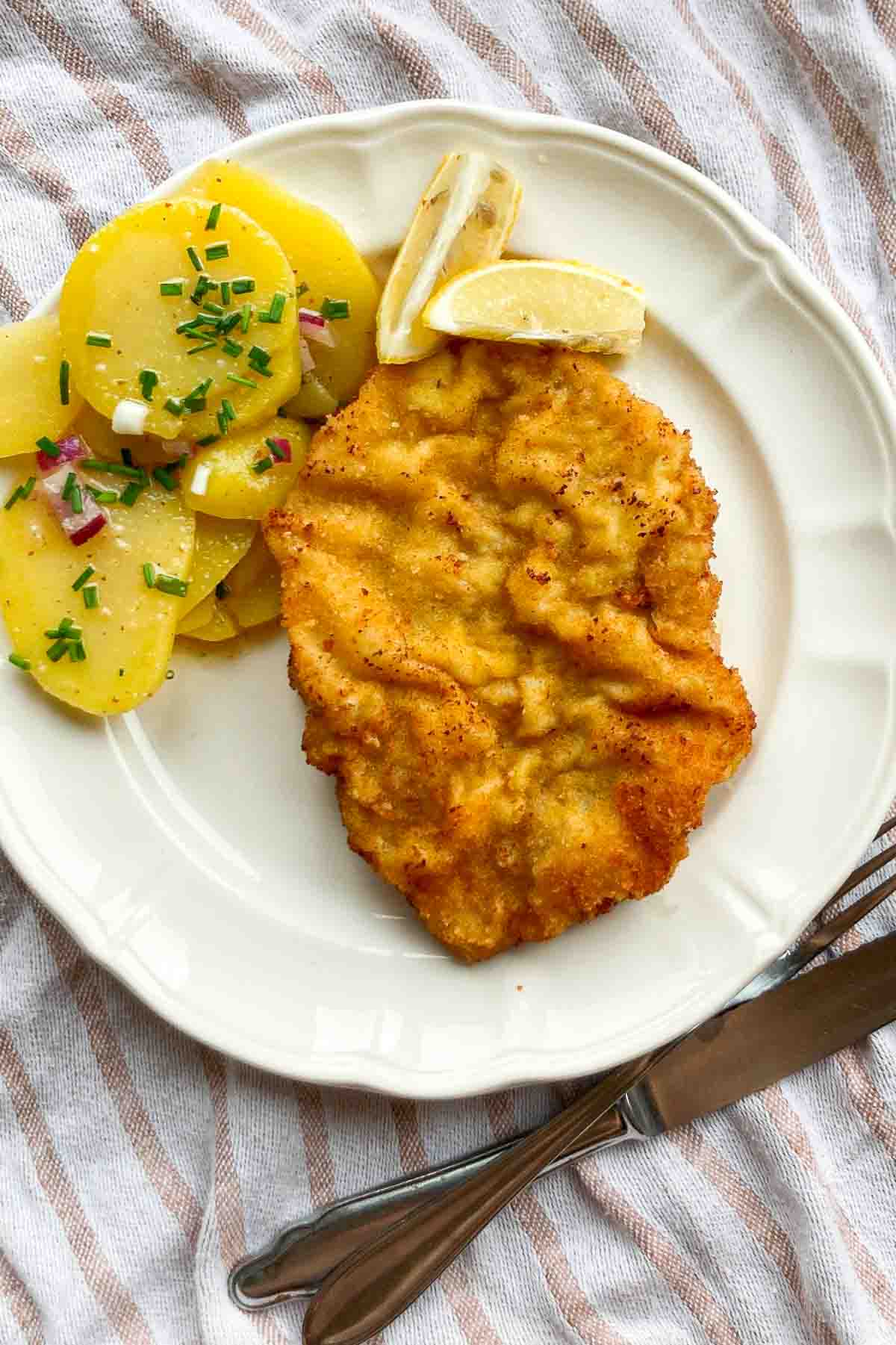
Jump to:
- Ingredients
- Side dishes for Wiener Schnitzel
- Instructions
- FAQ
- What is an Original Wiener Schnitzel ?
- Which meat for Wiener Schnitzel?
- Is Wiener Schnitzel served with sauce?
- Which flour to use for breading Schnitzel?
- Which fat to use for frying Schnitzel?
- Why does the breading come off the Wiener Schnitzel?
- How do I know if the fat for the schnitzel is hot enough?
- Viennese Schnitzel DOs and DON'Ts
- How to make an Authentic Wiener Schnitzel
When I started my blog on Viennese cuisine in 2015, I ignored Wiener Schnitzel for a long time because I thought the preparation was too banal, too simple, and that everyone already knew how to make it! ;D
Then I researched a bit more about the original Wiener Schnitzel and suddenly had great respect for publishing a guide because I saw how hotly debated the question of the "right" and "original" Wiener Schnitzel is, and I didn't want to make any mistakes…
But now here's a Schnitzel recipe from me anyway. Especially because I have learned a lot in the meantime, researched in many old cookbooks, and have fried many Schnitzels in my cooking classes that I used to hold ;D. And because there are only a few recipes on the internet that clearly and in detail show the preparation of an original Schnitzel step by step.

Ingredients
For an original Wiener Schnitzel, you need the following ingredients:
- Veal schnitzel - thinly sliced, preferably cut directly by the butcher. Important: good quality meat. For a schnitzel "in the Viennese style," pork is used instead.
- Fine salt
For breading, you need:
- Flour - coarse wheat flour, if possible (special spaetzle or dumpling flour), but it's also possible with all-purpose flour. No whole wheat flour, no rye flour, etc.
- Eggs - not too few, so that breading works well
- Breadcrumbs - unflavored (Here's how to make breadcrumbs easily in the blender)
For frying in the pan, you need:
- fat - traditionally, clarified butter, sometimes also pork lard, but very often vegetable oil such as rapeseed oil is used, which is a bit lighter and better digestible. - I personally like to use a mixture of about 70% rapeseed oil and 30% lard.
For serving:
- A lemon wedge
- Potato salad
- an anchovy ring with capers - optional
- lingonberry jam - optional
Equipment
- Sharp knife (if you cut the meat yourself)
- Cutting board
- foil to lay on while tenderizing the schnitzel - optional
- A cast iron or stainless steel pan is best for the high temperatures needed for a crispy schnitzel - coated pan like in the pictures also works
- Meat tenderizer with a smooth side (use a pan if you don't have a meat tenderizer with a smooth side)
- 3 deep plates or containers for breading
- Grill tongs without sharp prongs (or similar) for turning the schnitzel in the pan
Side dishes for Wiener Schnitzel
The most important and common side dish for Wiener Schnitzel is potato salad. Parsley potatoes, cucumber salad, and mixed salad also go well.
In some parts of Austria, rice or fried potatoes are also served, but personally, I find that too dry.
A lemon wedge must not be missing as a garnish. The lemon should only be placed next to the schnitzel just before serving so that the breading does not get soggy.
A sprig of curly parsley is almost always placed on the plate for decoration.
Anchovy rings with capers were common as a garnish at the beginning of the 20th century. The combination of lemon, anchovy ring, and caper is therefore also known as "Viennese garnish" and is served, for example, in the Viennese restaurants Meisl and Schaden. However, anchovy rings and capers are not mentioned in any of the classic Viennese cookbooks I used for my research.
Lingonberry jam is also frequently served with Wiener Schnitzel. However, I could not determine how "classic" and "traditional" it is in my research. In the most popular historic cookbooks of Austrian and Viennese cuisine, lingonberry jam is not mentioned.
Leftover cold schnitzel is best served cold with a bread roll, a gherkin, and mustard - which makes the perfect "Viennese burger". Schnitzel is not so good suited for reheating because the breading becomes soggy.
Instructions
1. Cutting and pounding schnitzel meat
Cut the sliced meat into a "butterfly cut" (see e.g. this Youtube Video), to make it bigger. Or have it pre-cut by the butcher.
Using the smooth side of a meat tenderizer, pound evenly to a thickness of approx. 5mm (~0.2 inches or ⅕ inch). Alternatively, use a pan for pounding ;D
A plastik foil on the schnitzel is optional when pounding the schnitzel but it helps to prevent it from splattering too much.
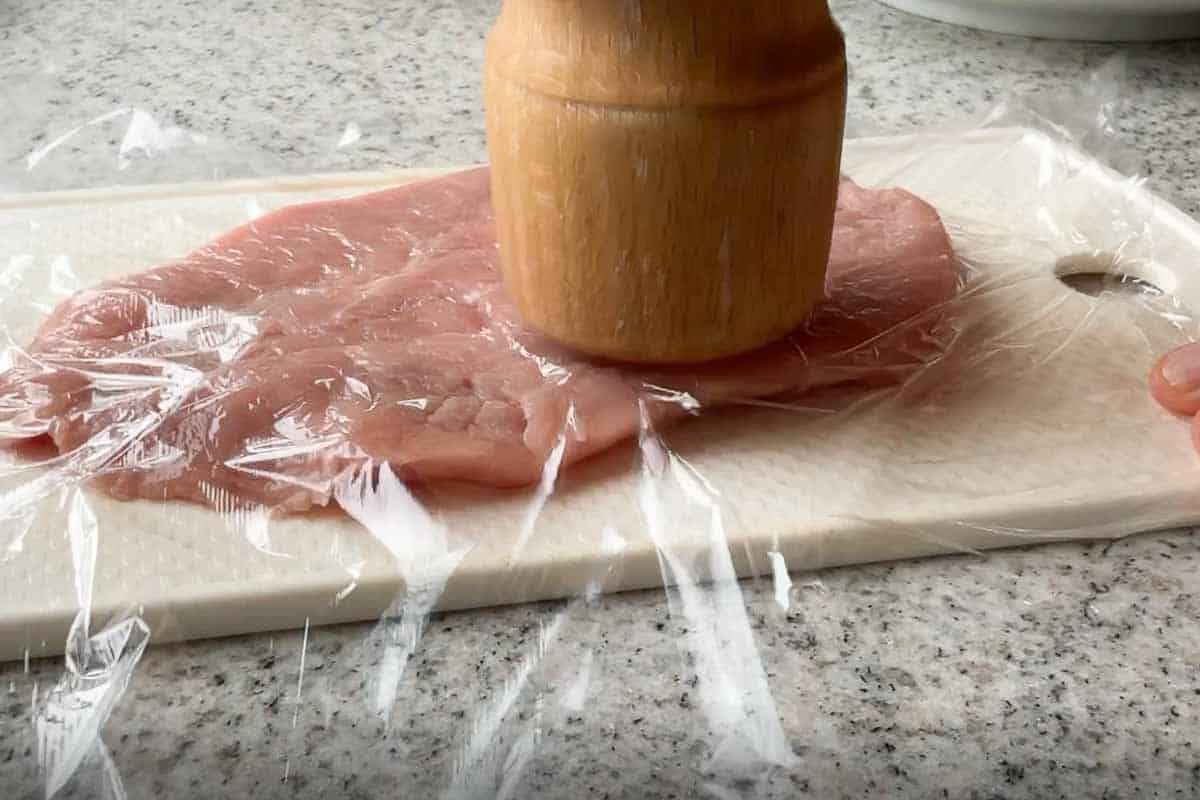
2. Preparations before the brading - the "Panierstraße" (Breadcrumb trail)
Prepare in 3 deep plates or other containers:
- flour
- beaten eggs
- breadcrumbs
Even more practical than plates are containers such as larger Tupperware boxes or roasting pans or similar, because they don't spill as much.

3. How to bread a Schnitzel
Salt the schnitzel on each side.
Dredge in flour on both sides. Tap off any excess flour.
Make sure that the entire schnitzel is covered with flour. Otherwise the breadcrumbs will not stick to the areas where there is no flour!
Now turn the schnitzel on both sides in the beaten egg. Again, let any excess egg drip off and make sure all areas are covered with egg.
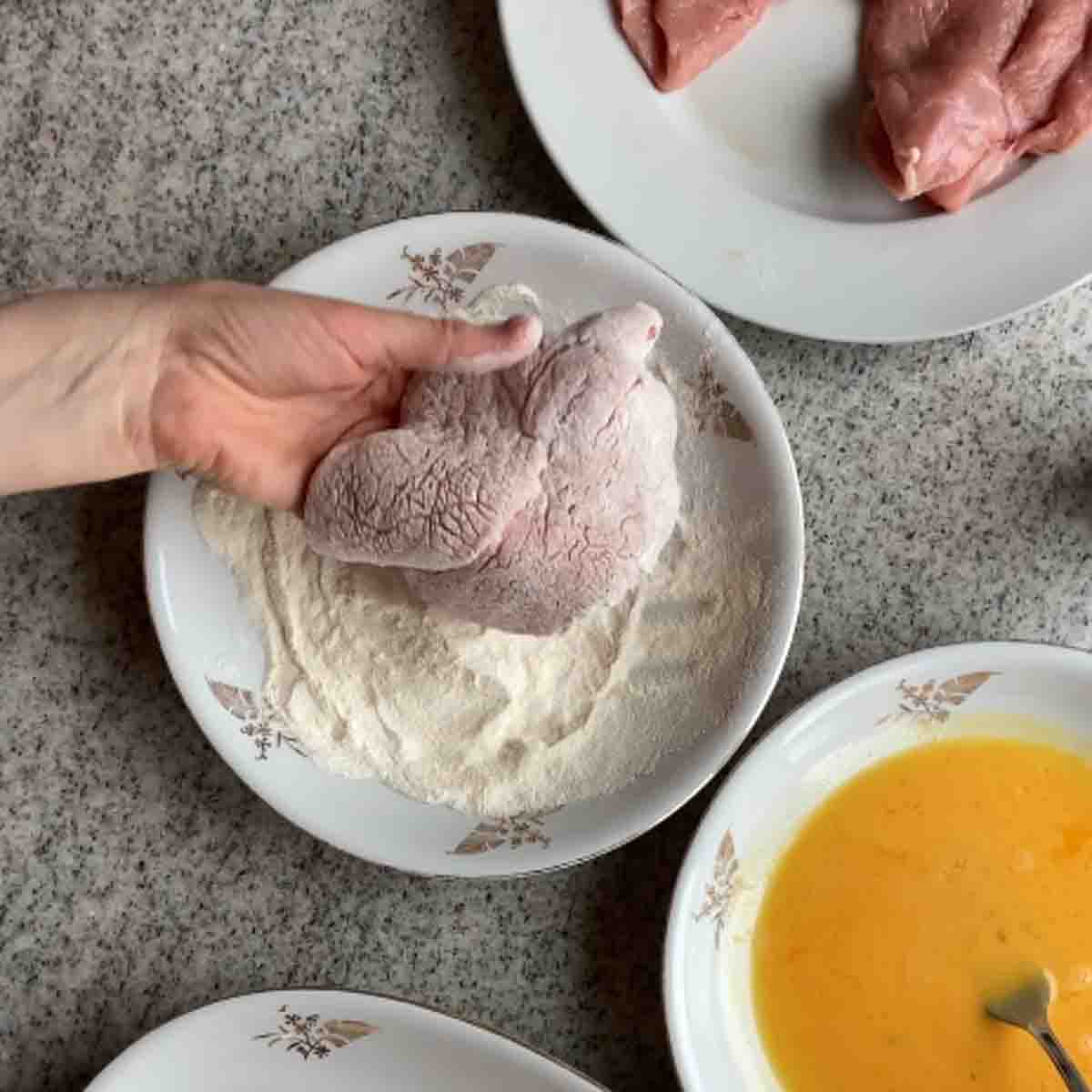

Then turn the schnitzel in the breadcrumbs. Do not press the breadcrumbs firmly onto the meat.

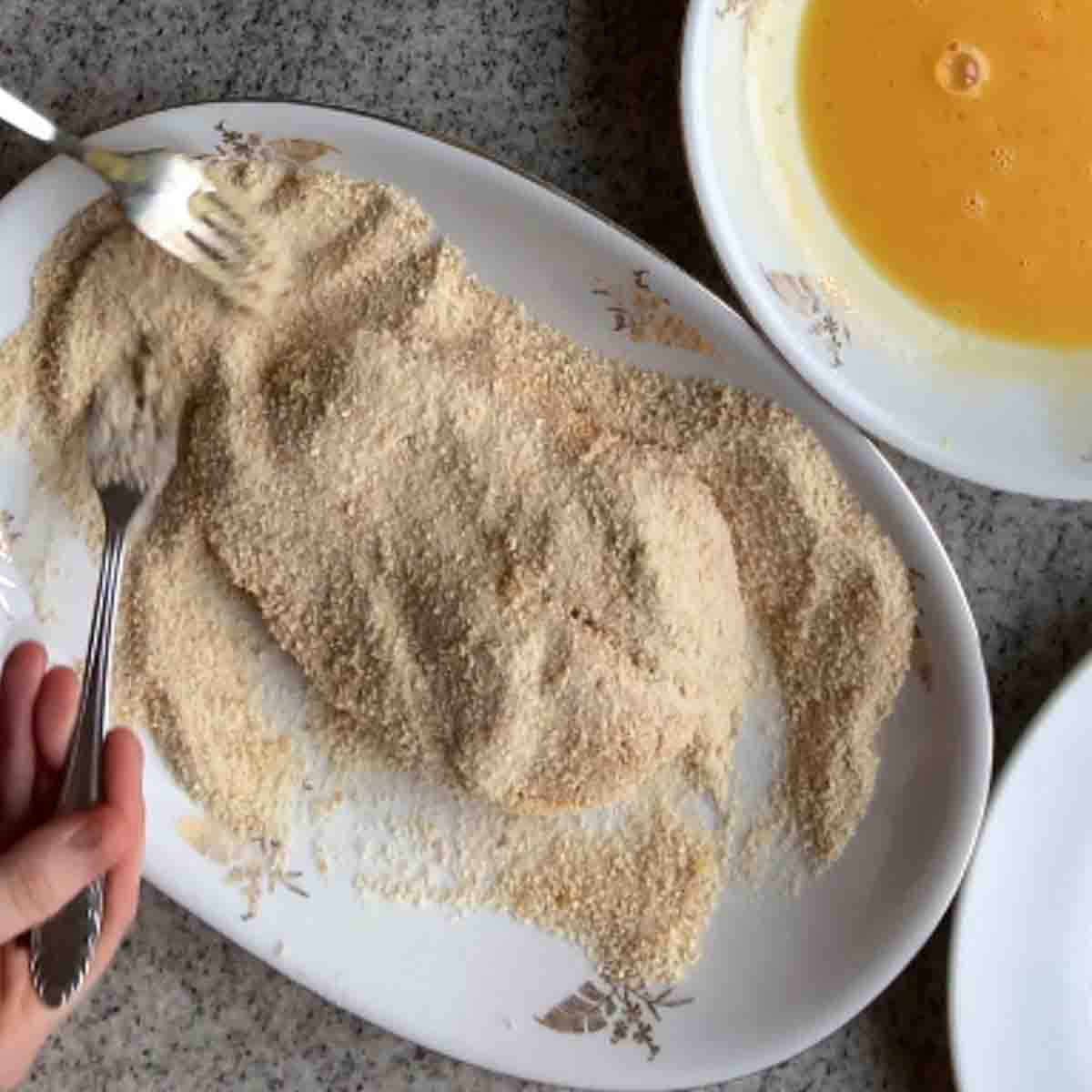

Now do this with all the remaining schnitzels in turn. The schnitzels should be placed in the hot pan immediately after breading - so it's best to bread them at the same time as you bake the first schnitzel.
4. Fry the schnitzel in the pan
Fill a pan about 2 fingers high with fat. There must be enough fat in the pan for the schnitzels to really float.
Heat the pan. The fat is at the right temperature when you throw in a few of the breadcrumbs and they form plenty of bubbles. Alternatively, you can dip the end of a wooden spoon into the fat. If small bubbles form, the schnitzels can go into the pan.
If you are making a lot of schnitzels, it pays to use two or more pans at the same time.
Fry the schnitzel on the first side for a few minutes. Swirl the pan in a circle 1-2 times so that some of the hot fat gets onto the top. This creates the wavy breading (= the breading soufflés).
If you make lots of Schnitzels, change the oil in the pan after about 4 Schnitzels. Otherwise the fat gets too dark and lots of the burnt breadcrumbs will stick to the Schnitzels that go in the pan the latest.

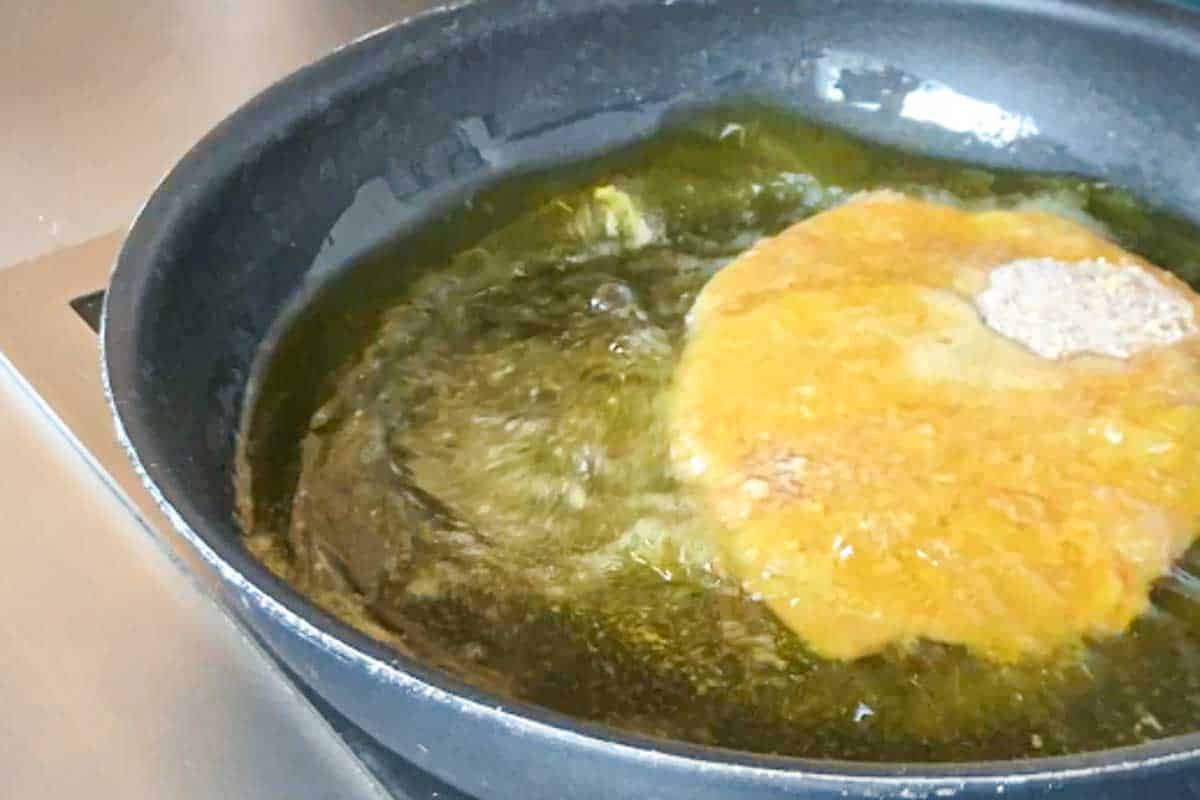
Depending on the thickness of the meat, turn after approx. 2-4 minutes and fry the other side until golden brown. In the meantime, adjust the temperature so that the fat does not get too hot.
Turn the schnitzel carefully so that the breading is not damaged. Do not prick the meat when turning, but use meat tongs without prongs or similar.
Drain on some kitchen paper and serve garnished with lemon. Enjoy your meal!
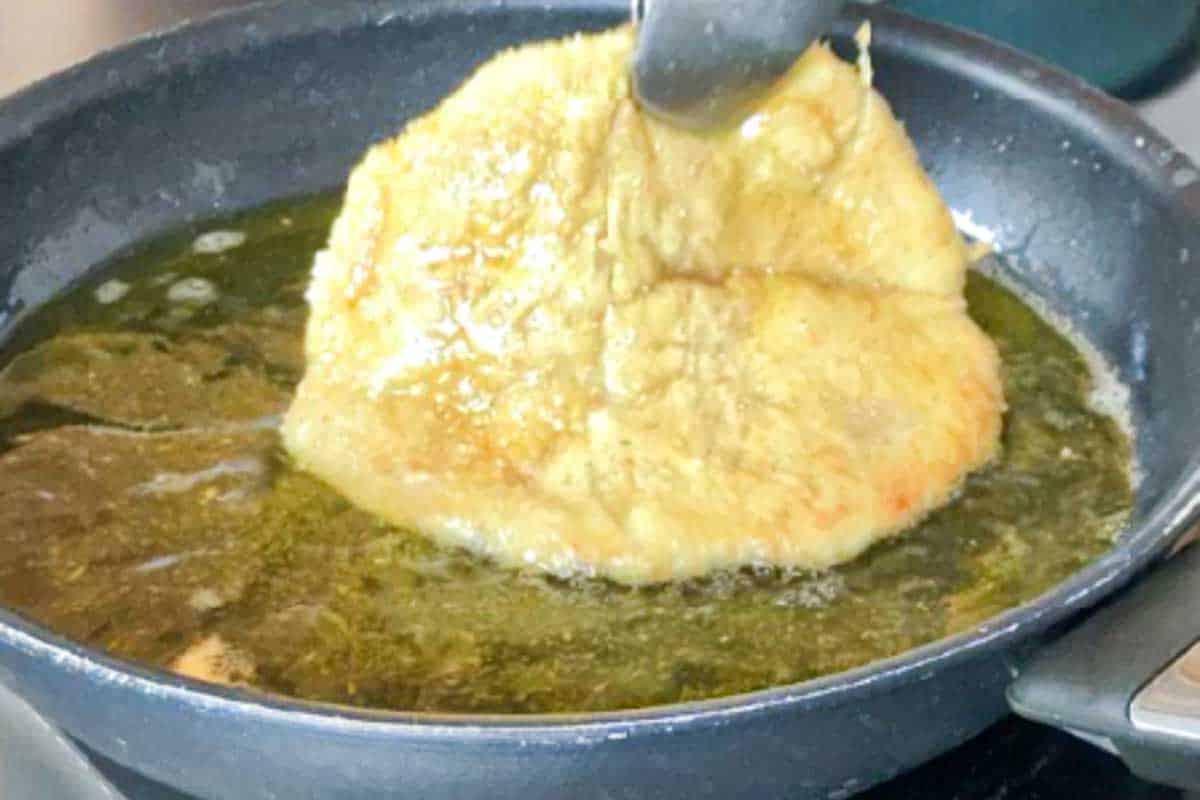
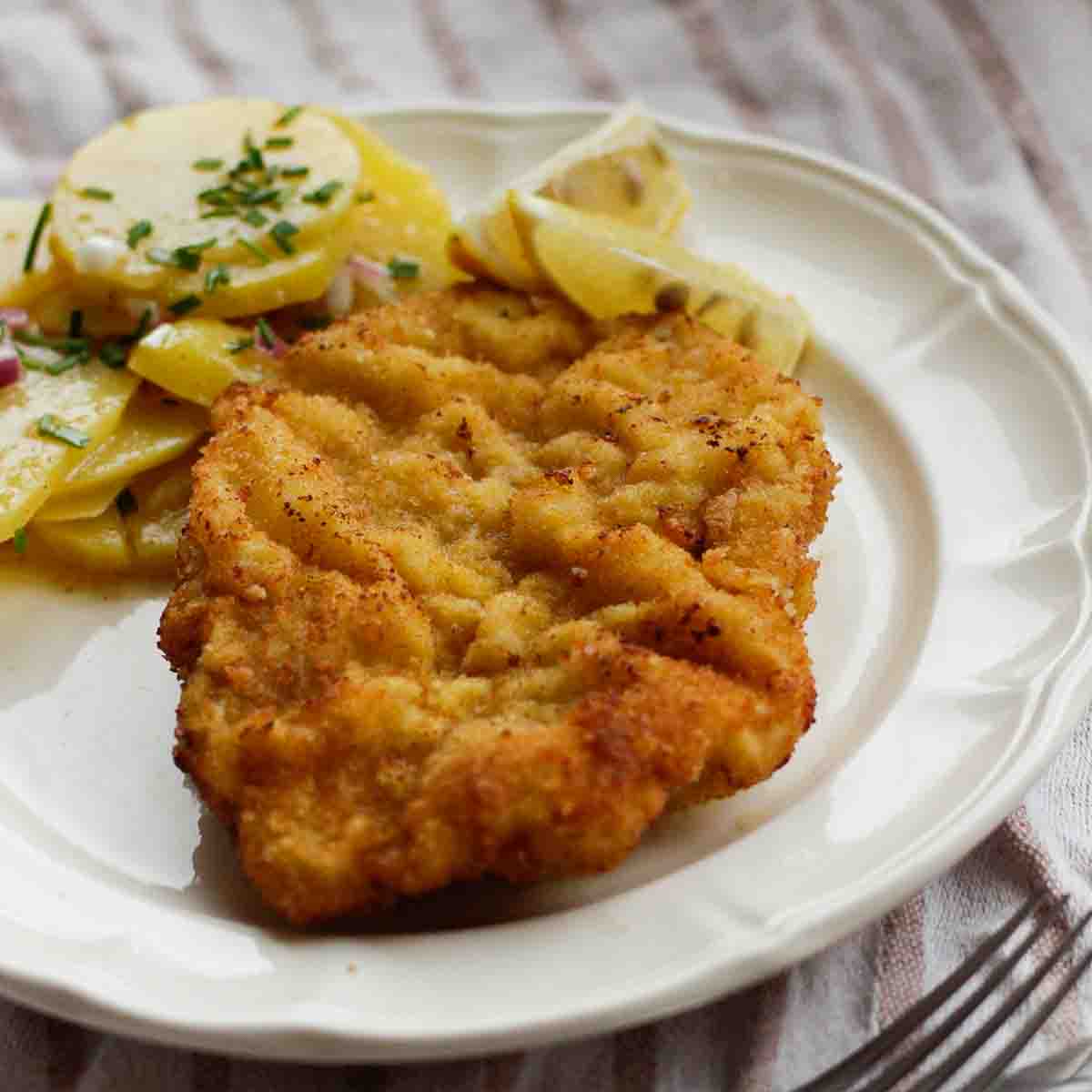

FAQ
What is an Original Wiener Schnitzel ?
An original Wiener Schnitzel is thinly sliced veal that is breaded in flour, egg, and breadcrumbs in succession and then fried in fat. The meat must come from veal to be called Wiener Schnitzel. Schnitzel "in the Viennese style" consists of pork.
Which meat for Wiener Schnitzel?
For Wiener Schnitzel, meat from the leg or top round of veal is used. It's best to mention at the butcher's counter that you need veal for Wiener Schnitzel . Then the staff can cut the meat thinly in a butterfly cut.
Is Wiener Schnitzel served with sauce?
In Austria and the Schnitzel capital Vienna ("Wien" in German), a Schnitzel is never (never ever!) served with any kind of sauce. (Unlike in Germany.)
At most, a tablespoon of lingonberry jam passes as a sauce accompaniment to the Schnitzel.
Which flour to use for breading Schnitzel?
Many chefs and restaurants use coarse flour for breading schnitzel (like dumpling or spaetzle flour). But good results can be achieved with all-purpose flour as well.
Which fat to use for frying Schnitzel?
Traditionally, clarified butter, and sometimes pork lard, are used for frying Wiener Schnitzel. However, vegetable frying oil has become more popular in recent decades. The end result tastes a bit lighter with vegetable oil. - Also, a mixture of about 70% rapeseed oil and 30% lard (or less) tastes very good.
Why does the breading come off the Wiener Schnitzel?
If the schnitzel is not completely covered with flour during breading, the breading can come off. The schnitzel must be completely covered with flour (really everywhere). Then the flour should be lightly tapped off. It's the flour that makes the beaten egg stick well to the Schnitzel. The egg should also cover everything completely. This allows the breadcrumbs to stick everywhere. If you work carefully during breading and frying, there should be no holes in the breading, and it should not come off.
On the other hand, if the breading bubbles during frying, that is, it "soufflés", then it is intentional and shows that everything has been done correctly!!
, but it's not when you've done it once ;).
How do I know if the fat for the schnitzel is hot enough?
Throw a few crumbs into the fat - as soon as the crumbs foam up and bubbles form, the fat has reached the right temperature.

Viennese Schnitzel DOs and DON'Ts
DOs - What to consider when cooking Viennese Schnitzel
- Buy schnitzel of very good quality from the butcher and possibly have it cut there.
- Gently tenderize with the flat side of the meat tenderizer.
- Optional: lightly spray with water before breading.
- When coating in flour, every tiny spot must come into contact with flour. Then tap off the excess flour.
- Place the schnitzels in the hot oil only.
- While frying, always swirl the pan and "shake" it a bit to prevent the schnitzels from sticking and to get some oil on the top.
- Ideally, fry the schnitzels on each side only once. (So turn only once)
Heavily disputed techniques for making schnitzel 😂
Austrians take their Schnitzel very seriously 😂. The following techniques for breading schnitzel are sometimes hotly debated in cooking forums and on social media.
- Pressing the schnitzel firmly into the breadcrumbs while breading: opinions differ here. Personally, I lightly coat the schnitzels with breadcrumbs (not pressing firmly) and have had good results. But I have also seen very crispy Schnitzels with firmly pressed breadcrumbs!
- Smooth or coarse flour: The opinions also differ here. For example, Figlmüller uses coarse flour, but I have seen perfect schnitzels with both types of flour.
- Beating eggs with milk or cream: opinions also differ here. Mixing eggs with milk or cream makes it easier to beat. It is also added to save eggs. For some, however, its use is sacrilegious 😂.
DON'Ts when breading Viennese Schnitzel
- Cheap meat: a schnitzel forgives nothing. Unlike with a stew or similar dish, nothing can be corrected afterwards with a schnitzel. Cheap meat is not only bad for the environment and the welfare of animals, but you also risk a bad schnitzel ;).
- Tenderize too strongly or too lightly: the schnitzel should be gently tenderized so that it is evenly thin everywhere.
- Tenderize with the serrated side of the meat tenderizer: this destroys the structure of the muscle fibers, which can result in tough schnitzels.
- Do not beat the eggs for too long, just beat them briefly.
- Breading sloppily: Flour, eggs, and breadcrumbs must always completely cover each piece of meat.
- Do not use too little fat in the pan. The Schnitzels must be able to swim.
- Put in the pan too early: The breading acts as a barrier between the meat and the oil. This allows for tender meat with a short frying time. If the schnitzel is put in the pan before the oil is hot enough, the breading will absorb too much oil too quickly. This can result in a tough schnitzel.
- Damage the breading when flipping: be careful when handling the breaded schnitzel. Do not pierce it with a serrated tong or fork while frying in the pan.


How to make an Authentic Wiener Schnitzel
Kochutensilien
- sharp knife (if you cut the meat yourself)
- cutting board
- foil to lay on while tenderizing the schnitzel (optional)
- pan (cast iron or stainless steel pan is best for the high temperatures needed for a crispy schnitzel - coated pan like in the pictures also works)
- Meat tenderizer (with a smooth side, use a pan if you don't have a meat tenderizer with a smooth side)
- 3 deep plates (or containers for breading)
- Grill tongs (without sharp prongs for turning the schnitzel in the pan)
Zutaten
For an original Wiener Schnitzel, you need the following ingredients:
- 4 veal schnitzel thinly sliced, preferably cut directly by the butcher. For a schnitzel "in the Viennese style," pork is used instead.
- fine salt
For breading, you need:
- 1 to 2 cups all purpose flour or a more coarse spaetzle or dumpling flour, no whole wheat flour, no rye flour, etc.
- 4 eggs or more
- 1 to 2 cups breadcrumbs unflavored
For frying in the pan, you need:
- fat traditionally clarified butter, sometimes also pork lard, but very often vegetable oil such as rapeseed oil is used, which is a bit lighter and better digestible. - I personally like to use a mixture of about 70% rapeseed oil and 30% lard.
For serving:
- 4 lemon wedges
- potato salad
- an anchovy ring with capers optional
- lingonberry jam optional
Anleitung
Cutting and pounding schnitzel meat
- Cut the sliced meat into thin Schnitzels, ideally using the "butterfly cut" (see blog article), to make them bigger. Or have it pre-cut by the butcher.
- Using the smooth side of a meat tenderizer, pound evenly to a thickness of approx. 5mm (~0.2 inches or ⅕ inch). Alternatively, use a pan for pounding ;D A plastik foil on the schnitzel is optional when pounding the schnitzel but it helps to prevent it from splattering too much.
Preparations before the brading
- Prepare in 3 deep plates or other containers: flour, beaten eggs, breadcrumbs.Even more practical than plates are containers such as larger Tupperware boxes or roasting pans or similar, because they don't spill as much.
- Note: Just slightly beat the eggs with a fork. Don't beat the eggs for too long,
How to bread a Schnitzel
- Salt the schnitzel on each side.
- Dredge in flour on both sides. Tap off any excess flour.Make sure that the entire schnitzel is covered with flour. Otherwise the breadcrumbs will not stick to the areas where there is no flour!
- Now turn the schnitzel on both sides in the beaten egg. Again, let any excess egg drip off and make sure all areas are covered with egg.
- Then turn the schnitzel in the breadcrumbs. Do not press the breadcrumbs firmly onto the meat.
- Now do this with all the remaining schnitzels in turn. The schnitzels should be placed in the hot pan immediately after breading - so it's best to bread them at the same time as you bake the first schnitzel.
Fry the schnitzel in the pan
- Fill a pan about 2 fingers high with fat. There must be enough fat in the pan for the schnitzels to really float.
- Heat the pan. The fat is at the right temperature when you throw in a few of the breadcrumbs and they form plenty of bubbles. Alternatively, you can dip the end of a wooden spoon into the fat. If small bubbles form, the schnitzels can go into the pan.
- If you are making a lot of schnitzels, it pays to use two or more pans at the same time.
- Fry the schnitzel on the first side until golden brown. Swirl the pan in a circle 1-2 times so that some of the hot fat gets onto the top. This creates the wavy breading (= the breading soufflés).In the meantime, adjust the temperature so that the fat does not get too hot (there should still be bubbles forming in the fat, but the Schnitzel should not get dark too soon).
- Depending on the thickness of the meat, turn after approx. 2-4 minutes and fry the other side until golden brown. Turn the schnitzel carefully so that the breading is not damaged. Do not prick the meat when turning.
- If you make lots of Schnitzels, change the oil in the pan after about 4 Schnitzels. Otherwise the fat gets too dark and lots of the burnt breadcrumbs will stick to the Schnitzels that go in the pan the latest.
- Drain on some kitchen paper and serve garnished with lemon. Enjoy your meal!
(c) by Angelika Kreitner-Beretits / Vienna Sunday Kitchen
März 24, 2024 Hast du das Rezept ausprobiert? Dann freue ich mich über deine Bewertung!! / Rate this Recipe!Notizen
You may also be interested in the following Austrian recipes:

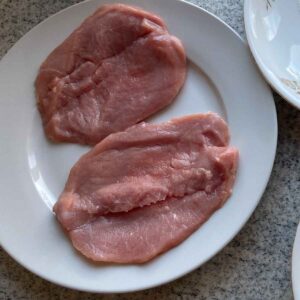



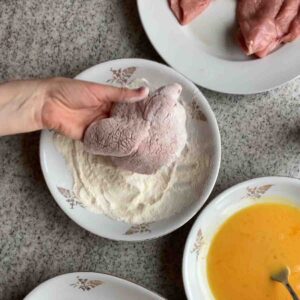
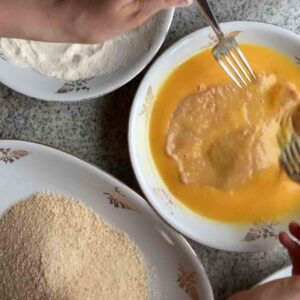




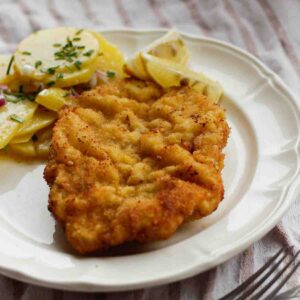
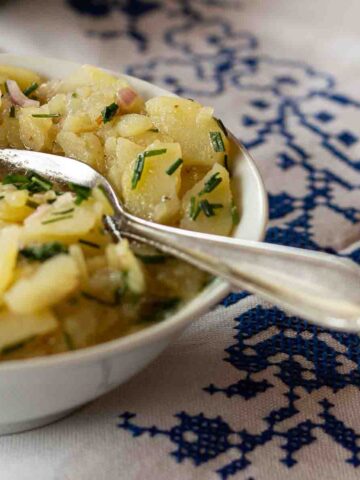



Ich freu mich über deine Rückmeldung zum Rezept in den Kommentaren!